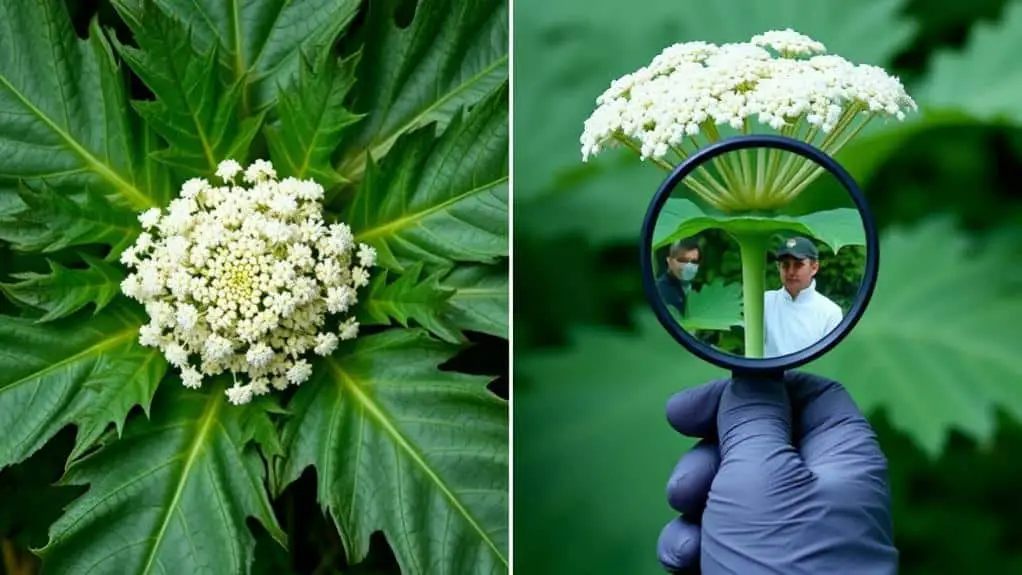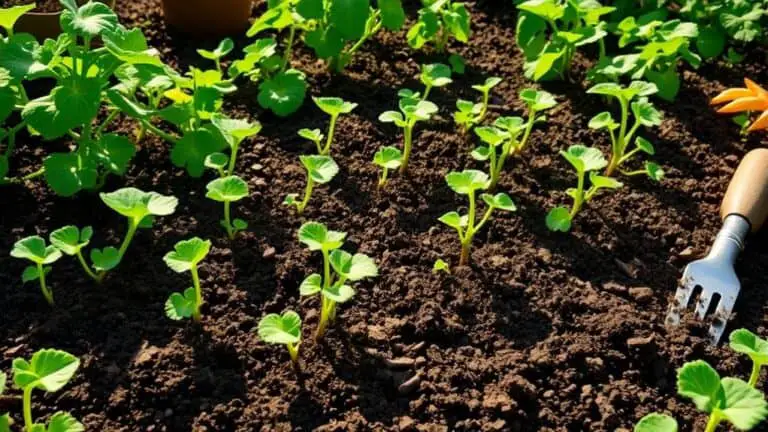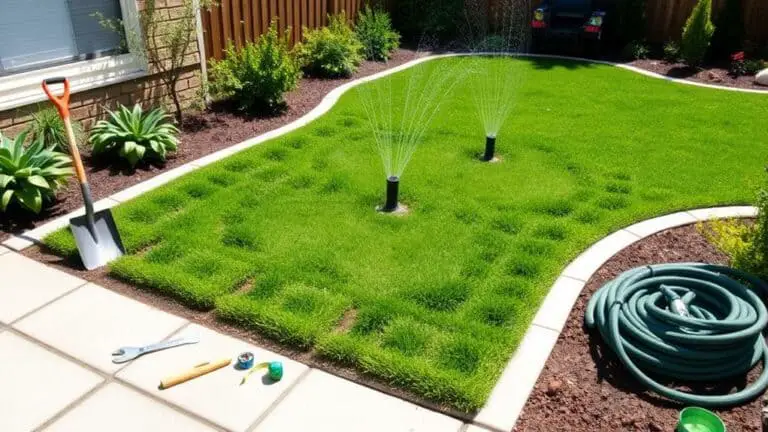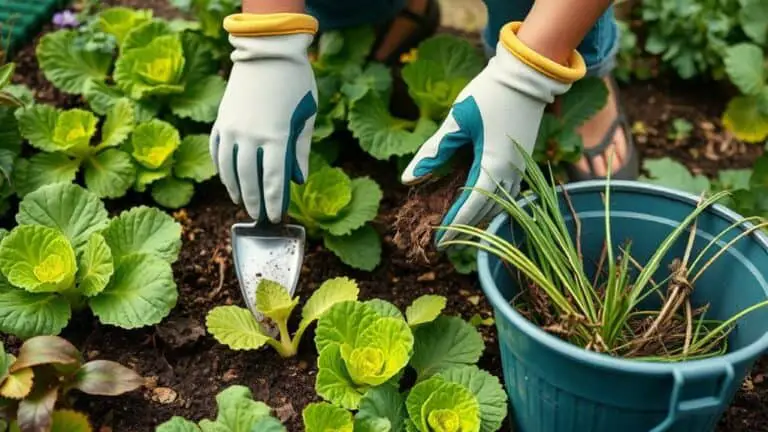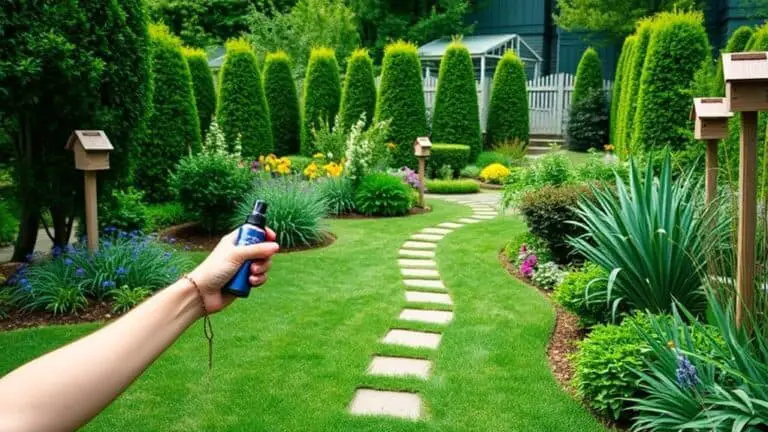How To Get Rid Of Giant Hogweed Safely
When it comes to getting rid of giant hogweed safely, the first thing you need to do is protect yourself with proper gear—think heavy-duty gloves, long sleeves, and safety goggles. This plant’s sap can cause severe skin reactions, especially in sunlight, so it’s essential to minimize exposure. Manual removal involves digging up the entire plant, roots and all, preferably on cloudy days. If you’ve got a larger infestation, you might need to use herbicides like glyphosate, but be sure to follow local guidelines. Wondering how to handle disposal without risking regrowth? Let’s get into that next.
Identifying Giant Hogweed
Identifying giant hogweed is essential to avoid its hazardous effects and manage its invasive spread.
When you’re trying to spot this plant, look for its towering height—anywhere from 3 to 5 meters tall. The leaves are large and jagged, up to 1 meter across. The hollow stems, which can be 4 to 10 cm in diameter, have distinctive reddish-purple blotches.
The flower heads form large umbels with white clusters that can span up to 80 cm. Each giant hogweed plant can produce between 20,000 to 100,000 seeds annually, making it a prolific invader.
Avoid contact with this plant, as the sap of giant hogweed contains toxic chemicals that cause severe skin burns and photodermatitis when exposed to sunlight.
Health Risks of Giant Hogweed
When dealing with giant hogweed, it’s crucial to understand the health risks associated with this invasive plant. The sap contains toxic compounds that can seriously harm your skin.
Here are the key health risks to be aware of:
- Skin Burns and Blistering: Contact with giant hogweed sap, especially in sunlight, can cause severe burns and blisters.
- Long-lasting Effects: Exposure may lead to pigmentation changes and scars lasting for months, with skin sensitivity persisting for years.
- Eye Injuries: If sap enters your eyes, it can cause temporary or permanent blindness.
- Children’s Vulnerability: Kids are more prone to severe reactions due to their sensitive skin.
Always use protective clothing, like gloves and long sleeves, to minimize these risks.
Protective Gear and Clothing
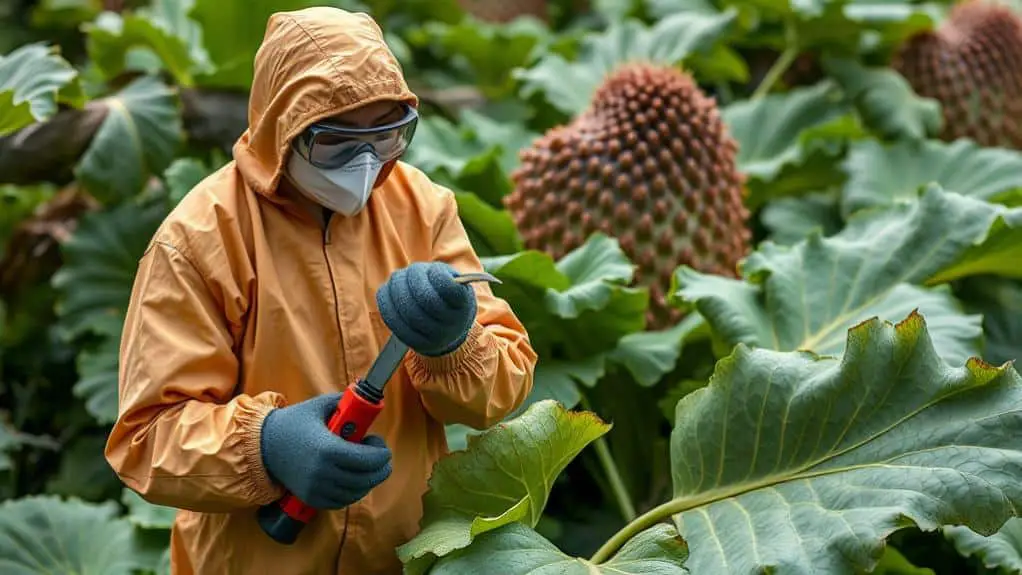
When handling giant hogweed, it’s essential to wear long sleeves, gloves, and closed footwear to protect your skin from its toxic sap.
A rain suit and safety goggles offer additional protection, especially when cutting or mowing the plant.
Don’t forget to wash any contaminated clothing and tools thoroughly to prevent accidental exposure.
Essential Protective Clothing
Dealing with giant hogweed requires stringent safety measures to protect yourself from its toxic sap. Here’s what you need to wear:
- Protective Clothing: Use long sleeves and closed footwear to minimize skin exposure.
- Gloves: Essential for handling the plant, as direct contact with the sap can cause severe skin irritation.
- Eye Protection: Goggles or face shields are vital to prevent sap from splashing into your eyes, which can lead to serious injury.
- Rain Suit: Especially useful in wet conditions, providing an effective barrier against sap.
Additionally, consider wearing a mouth mask if you’re mowing large fields of giant hogweed to avoid inhaling airborne particles.
Regular breaks can also help reduce prolonged exposure and associated risks.
Stay safe out there!
Handling Sap Safely
Handling the toxic sap of giant hogweed demands utmost caution and the right protective gear. You must wear protective clothing, including long sleeves, gloves, and closed footwear to minimize skin exposure. A facemask helps prevent inhaling any airborne particles.
I can’t stress enough how important this is for handling sap safely. After working with giant hogweed, wash clothing and tools thoroughly to eliminate any lingering sap residues. This prevents accidental future contact that could lead to severe burns.
Also, aim to work on overcast days. Sunlight can react with any sap on your skin, exacerbating burns. Taking these steps will greatly reduce your risk while dealing with this hazardous plant.
Importance of Eye Protection
While protective clothing and gear are essential for safe giant hogweed handling, eye protection stands out as particularly important. Contact with the sap can cause severe eye damage, including temporary or permanent blindness, especially when exposed to sunlight.
To safeguard your eyes, always wear safety goggles that fully cover them. Here’s a quick checklist for eye protection:
- Wear safety goggles: Make certain they fit snugly to prevent any sap splashes.
- Avoid touching your face: Keep your hands away from your eyes during removal activities.
- Be aware of surroundings: Accidental contact can occur during routine outdoor activities.
- Seek medical attention: If sap contacts your eyes, rinse thoroughly with water and seek medical help immediately.
Stay safe and protect your vision!
Manual Removal Techniques
When removing giant hogweed manually, I always make certain to wear protective clothing to prevent skin contact with the plant’s toxic sap.
I find that digging when the soil is moist helps loosen the roots, making it easier to extract the entire plant and reducing the risk of regrowth.
Regularly checking for new shoots, especially during summer, guarantees any missed fragments are promptly removed.
Protective Clothing Essentials
Before tackling the challenging task of removing giant hogweed, it’s crucial to arm yourself with the right protective clothing to safeguard against its toxic sap.
This sap can cause severe burns, blistering, and even blindness if it comes into contact with your skin or eyes.
Here’s what you need:
- Gloves: Wear heavy-duty gloves to prevent skin contact with the toxic sap.
- Eye Protection: Use safety goggles to protect your eyes from splashes.
- Full Rain Suit: Consider a full rain suit for an added layer of protection.
- Facemask: A facemask will help you avoid inhaling any harmful particles.
Ensure all protective gear is thoroughly washed after use to prevent accidental exposure later.
Effective Digging Practices
Taking on the task of removing giant hogweed manually requires not only determination but also effective digging practices to ascertain success.
First, always wear protective clothing like gloves, long sleeves, and face masks to avoid sap contact.
Dig during moist soil conditions to ascertain you can extract the entire root system—leaving any fragments can lead to regrowth. This effective method of control involves removing all above and below-ground parts.
After digging, monitor the area regularly for regrowth, as seeds can sprout even after a decade.
Chemical Control Methods
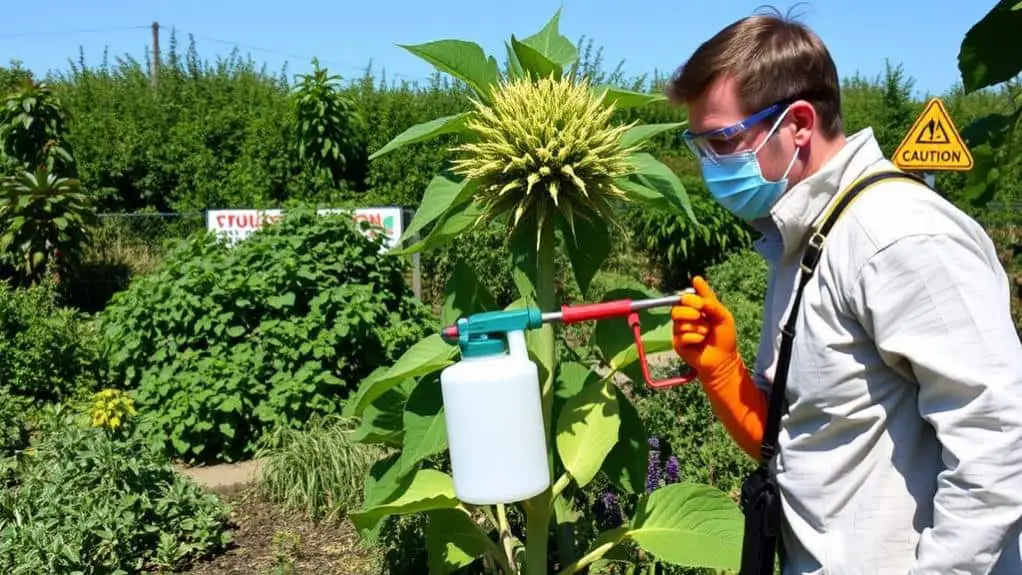
Applying chemical control methods to tackle giant hogweed can be both effective and manageable with the right approach.
Using glyphosate-based herbicides is recommended, especially on young foliage from April to May before the plant flowers.
Follow these steps to guarantee success:
- Apply herbicide to all visible plants to prevent seed blow-in and future infestations.
- Avoid herbicide runoff into waterways by obtaining Environment Agency permission for spraying near water sources.
- Repeat treatments over 4-5 years to deplete the seed bank and prevent regrowth.
- Monitor and adjust your treatment plan based on infestation extent and environmental conditions.
Safe Disposal of Cuttings
When disposing of giant hogweed cuttings, it’s essential to follow proper waste handling to prevent regrowth.
I always dry the cuttings in sealed plastic bags under the sun for a week before taking them to a licensed landfill site.
Remember to wear protective gear to avoid sap exposure and make sure cuttings don’t touch soil or water.
Proper Waste Handling
Handling giant hogweed cuttings requires careful attention to proper waste disposal to prevent its spread and protect both the environment and human health. Since giant hogweed cuttings are classified as controlled waste, you must dispose of them with care.
Here’s how you can manage this safely:
- Wear protective clothing: Always use gloves, long sleeves, and eye protection to avoid contact with the plant.
- Bag and dry: Place dried cuttings in plastic bags and leave them in sunlight for a week.
- Document disposal: Confirm all cuttings are sent to licensed landfill sites with proper documentation.
- Avoid human contact: Handle all materials cautiously to prevent skin irritation or more severe reactions.
Avoid Regrowth Risks
Disposing of giant hogweed cuttings correctly is crucial to avoid the risk of regrowth and prevent spreading its seeds. Always treat these cuttings as controlled waste.
Place the cuttings in plastic bags and leave them in sunlight for at least a week; the plant is sensitive to sunlight, and this will kill any viable seeds.
Never compost or discard them in regular waste, as that can lead to re-establishment.
Thoroughly wash all tools and clothing that come into contact with giant hogweed to avoid accidental seed transport or skin irritation from its sap.
Licensed Disposal Sites
Properly managing giant hogweed cuttings involves more than just preventing regrowth risks; it also requires using licensed disposal sites for safe and compliant disposal.
These cuttings are classified as controlled waste, necessitating their disposal at licensed landfill sites that meet strict environmental regulations. To guarantee you’re compliant, follow these steps:
- Contact your local authorities to find the nearest licensed landfill sites.
- Use proper documentation to accompany the off-site disposal, adhering to waste management laws.
- Avoid direct contact with the cuttings during disposal to prevent exposure to the toxic sap.
- Check local guidelines regularly to stay updated on disposal protocols.
Preventing Spread and Regrowth
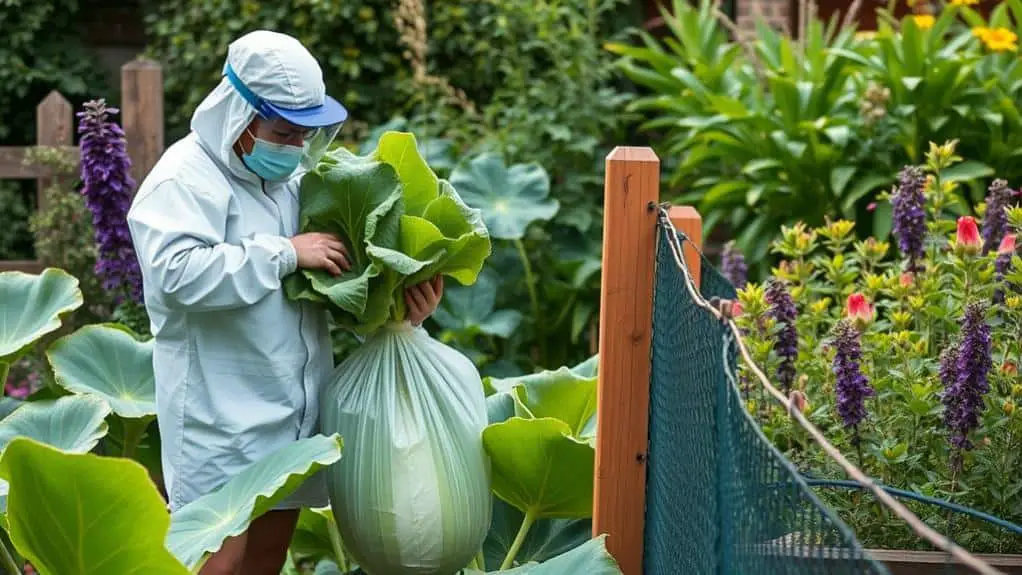
When you’re tackling giant hogweed, preventing its spread and regrowth is absolutely essential. Start by mowing the plant from early May to stop seed heads from forming. Remember, a single plant can produce up to 100,000 seeds. Dispose of cuttings as green waste in sealed plastic bags to avoid regrowth. Removing flower heads before they fade is a key control method to reduce seed production.
| Task | Action |
|---|---|
| Mowing | Early May to prevent seed formation |
| Disposing Cuttings | Sealed plastic bags to avoid regrowth |
| Removing Flower Heads | Before they fade to reduce seeds |
Always clean clothing, tools, and equipment thoroughly after working in affected areas to prevent spreading seeds to new locations.
Monitoring and Maintenance
Regularly monitoring and maintaining areas where you’ve removed giant hogweed is essential for keeping this invasive plant in check.
It’s vital to stay vigilant, as new growth can emerge for up to 10 years. Here are some practical steps for effective long-term management:
- Monitor frequently: Check for new seedlings or regrowth regularly.
- Mowing schedule: Implement a mowing schedule, cutting at least five times during the growing season to prevent seed formation.
- Document locations: Keep records of new infestations and share information with neighbors and local authorities.
- Clean equipment: Always clean machinery, clothing, and tools after working in affected areas to prevent accidental seed dispersal.
Adapting your control methods as needed will guarantee you stay ahead of this persistent plant.
Legal Regulations and Compliance
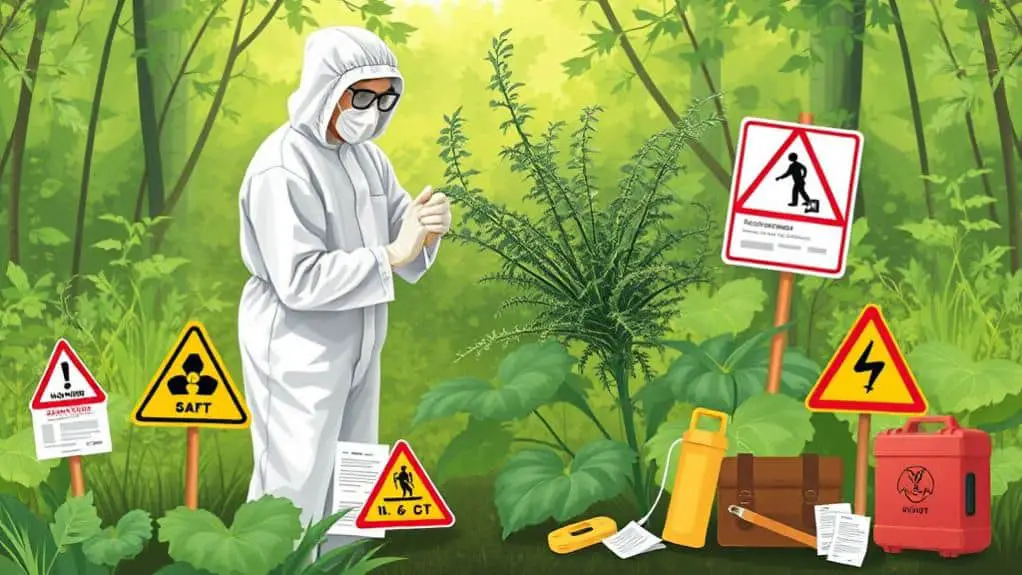
Understanding and adhering to legal regulations is vital when dealing with giant hogweed, as non-compliance can lead to severe consequences.
Since giant hogweed is an invasive species, European Regulation (EU) 1143/2014 prohibits its possession, trade, and transport. The Wildlife and Countryside Act 1981 makes it illegal to plant or allow its growth in the wild.
You’re required to manage and trace its populations to prevent environmental damage. Disposal of giant hogweed must be documented as it’s classified as controlled waste.
Compliance with these regulations isn’t just about avoiding fines—it’s essential for effective invasive species management. Always make sure you’re following these legal guidelines to protect both the environment and yourself from potential legal issues.
Seeking Professional Help
Tackling giant hogweed on your own can be intimidating and dangerous, which is why seeking professional help is highly advisable.
Professionals are equipped to handle the health risks associated with this toxic plant. Here’s why you should consider their expertise:
- Health Risks: Professionals know how to avoid severe skin reactions caused by the plant’s sap.
- Removal Strategies: They develop tailored strategies, including herbicide treatments and mechanical removal.
- Compliance: Experts guarantee adherence to legal regulations, minimizing environmental impact.
- Ongoing Management: They provide monitoring plans to prevent future regrowth.
Using professional services guarantees safe and effective eradication of giant hogweed, protecting both you and the environment from potential hazards.
Supporting Resources and Contacts
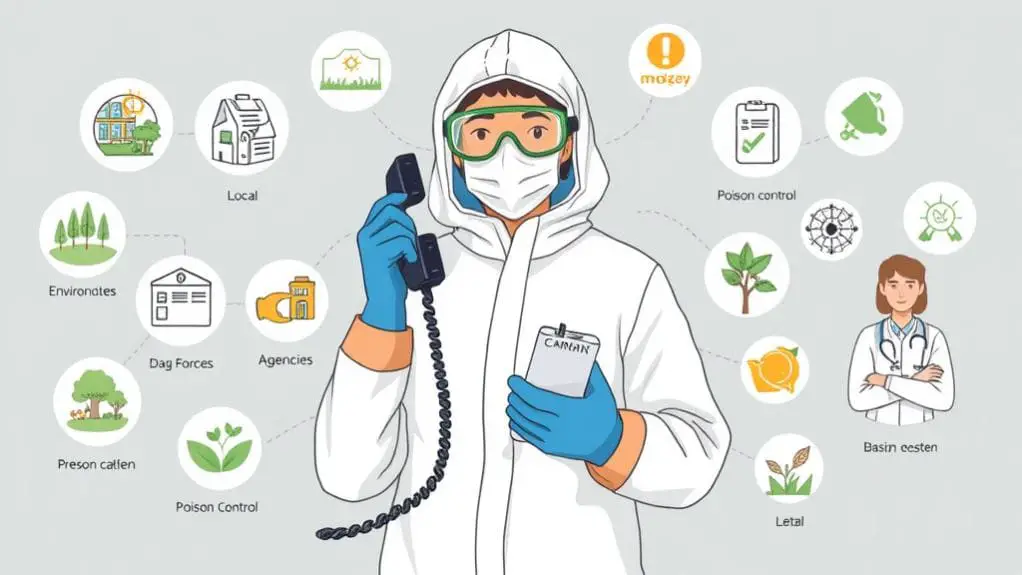
While professionals can handle giant hogweed effectively, knowing where to find support and resources is equally important for a thorough approach to this invasive plant.
Wageningen University & Research offers expert guidance on giant hogweed control strategies. I recommend reaching out to CJ (Chris) van Dijk, a specialist in invasive species, for tailored support.
Community collaboration is essential; local municipalities often coordinate efforts to manage giant hogweed populations.
Additionally, compliance with the European Union’s Regulation (EU) 1143/2014 guarantees legal management of invasive species.
Staying informed with the latest research on giant hogweed management can greatly enhance your eradication efforts.
These supporting resources are invaluable for effective and safe giant hogweed control.
Frequently Asked Questions
What Is the Best Way to Get Rid of Giant Hogweed?
When dealing with giant hogweed, I combine herbicide application and manual removal. Always prioritize safety precautions; wear protective gear. By doing this, I minimize environmental impact and effectively manage this invasive plant.
What Should You Do if You Get Stung by Giant Hogweed?
If you get stung by giant hogweed, wash the area with soap and water immediately. Protect your skin from sunlight. For severe giant hogweed symptoms, seek medical treatment. First aid measures include rinsing eyes thoroughly and avoiding UV exposure.
What Do You Do if You See Giant Hogweed?
Did you know giant hogweed can grow up to 5 meters tall? If you see it, maintain a safe distance and report it. Identifying giant hogweed and controlling its growth helps reduce its environmental impact. Safety precautions are essential.
What Happens if You Touch Giant Hogweed?
If you touch giant hogweed, you’ll likely experience severe skin reaction symptoms like blistering and long-term effects such as scarring. Giant hogweed identification is essential. Always use protective measures like gloves and eyewear to avoid its toxic sap.
Conclusion
Imagine you’re a knight facing a formidable dragon. With your armor (protective gear) and sword (manual and chemical methods), you can conquer this beast. Remember, vigilance is key—monitor your territory and adhere to the kingdom’s laws (local regulations) for safe disposal. If the dragon proves too fierce, call upon a skilled warrior (professional help). Armed with knowledge and caution, you can reclaim your garden from the giant hogweed’s grasp. Stay safe and fight smart!

